Subscribe now to get notified about IU Jharkhand journal updates!
Government Intervention - Awareness & Outreach Among Handloom Weavers in Varanasi
Abstract :
Handloom industry plays a vital role in contributing to the GDP and cultural importance of the country. This paper is focused on the various government interventions for the upliftment of handloom weavers , its outreach and satisfaction level among them. The industry has been facing the brunt since long in spite of tireless efforts of Government. The handloom industry has kept itself relevant and contributed in GDP of the country. This has been realizable because of aid from Government since independence and unmatched skills of the handloom weavers. The paper is descriptive in nature and is divided into four major parts i.e. introduction about handloom industry , description about the various schemes ,problem statement & data analysis, conclusions & Suggestions. The paper illustrates that handloom sector is gets strong backing from government by through its policies & interventions. The awareness level is found to be 80.55% among the handloom weavers. Health care schemes have found to have more awareness. The newly launched intervention i.e. Trade facilitation has high level of satisfaction among those who are availing it, but the outreach has been reported to be low. Based on the analysis of awareness and satisfaction level for all the schemes suitable suggestions have been made.
Keywords :
Awareness, Government interventions, Handloom industry, Satisfaction level, OutreachIntroduction :
India has rich culture of handlooms where Varanasi has
garnered itself as the cultural capital of this heritage. The city is
famous for its brocade and saris. The products of the Handloom
industry have the worldwide reputation since long time, and it
plays a very important role in Indian economy contributing 4%
in GDP and it is an integral component of textile industry
(IEBF). As per India Brand equity Foundation(IEBF) the export
of handloom products from India stood at US$ 357.53 million in
FY2016-17contributing 4% in GDP and it is an integral
component of textile industry. As per India Brand equity
Foundation(IEBF) the export of handloom products from India
stood at US$ 357.53 million in FY2016-17. As per Government
of U.P , Varanasi hand weaving silk industry is worth 80
million dollar including 20 million dollar export. Government
has consistently played a catalytic role in development of this
sector through implementation of various schemes along with
other important interventions.
The decadence of handloom industry commenced from 19
century due to industrialization which took place when trade
and market liberalization came into being. The textile industry
contributes nearly 20% of total industrial production and also
one-third of total exports. It provides employment to around
20 million people. Competition from power-loom is the most
important attribute of industrialization. Handloom weaving
faces a stiff competition from market with new technologies
and foreign manufactured products. In recent years, the
power-looms have achieved a considerable share in the
industry. The share of power-looms have increased from 37 %
to 68% (Textiles Annual Report, 2012-13) from 1980 to 1995 in
India's total textile production. The handloom woven fabrics
have an edge over machine woven fabrics because of
unrivaled level of accomplishments, elaborations and
muddleness. The fabrics which are weaved using handlooms
are still beyond the span of power looms in terms of designs
and embellishment.
In Varanasi, the operational model of weaving has four pillars
namely a)Independent/Individual Weavers b)The Master
weaver. c)Loom less individual weaver and d)Cooperative
weavers. The cooperative weavers work under the registered
government Co-operative institutions. Loom-less Weavers do
not have loom of their own and are employed under master
weaver's factory premises. They get the supply of raw material
(yarn) from master weavers and in turn wages are being paid.
Wages are decided on the basis of negotiating power of the
weavers and intricacies of the designs. Albeit the negotiating
power of weavers has drained substantially during the last
decade as the industry is facing a downtrend. One more type of
loom less weavers are the ones who have been given a loom by
master weaver and are installed at their home. The traders are
the owners of the loom and weavers are paid the wages. The
Independent weavers are not under the Wages system. The
Independent weavers have their own loom, purchase own raw
material from supplier on credit, weave the fabric and then sell
it to the Gaddidar directly or through master weaver. Master
weavers designs and weaves himself and also employs other
weavers who weave for him on his loom or on the weaver's
own handloom. Independent weavers are not able to get a
better price because of lack of holding capacity, fluctuating raw
material prices and payment delaying tactics of the traders. The
weaving activity requires yarn, preparation of warp and waft
and along with that weavers have to combat the volatility of
market. So, working under Mahajan/Gaddidar is the only way
out left. As far as number of active weavers are concerned there
are 51217 registered weavers in Varanasi
.(http://www.handloomcensus.gov.in/)
Overview of Various Schemes
Some of the government schemes for development and welfare
of handlooms weavers for providing holistic and sustainable
development to weavers are:
1. Trade Facilitation Center & Crafts Museum
2. Mahatma Gandhi Bunkar Bima Scheme (MGBBY)
3. Weavers' Health Insurance Scheme (HIS)
4. Yarn Supply Scheme
5. Revival Restructuring & Reform Scheme (RRR)
6. Comprehensive Handlooms Development Scheme
(CHDS)
The schemes mentioned cater to different requirements of
handloom weavers. Here is a brief description :
Revival Reform & Restructuring (RRR) Package for Handloom Sector
A package of Rs.3884 crore was approved by the Government on 24.11.2011 in the year 2011-12 under Revival, Reform & Restructuring (RRR) scheme for the benefit of 15,000 cooperative societies and 300,000 weavers across the country. Implementation of RRR package is being done by NABARD. RRR Package has been modified in order to conquer the practical obstacles in its application & utilization, to cover more apex societies, primary weaver cooperative (PWC) societies and individual weavers. The revised scheme helps in availing cheaper credit @ 6% of interest to the handloom sector. RRR Package also provides working capital loan to handloom weavers who are not covered under loan waiver package.
Comprehensive Handloom Development Scheme
CHDS is formed by merging the components of Integrated
Handloom Development Scheme (IHDS), Marketing & Export
Promotion Scheme (MEPS), Diversified & Handloom
Development Scheme (DHDS) which was implemented during
the 11th Plan. The aim is to develop Mega Handloom Clusters
specializing in specific products. The same can be attained by
improving facilities like infrastructural support, technology
enhancement ,creation of work shed, skill up-gradation,
design inputs which are in vogue, healthcare facilities etc. In
this scheme, financial assistance is given to Clusters, having
5000 handlooms per cluster and 300-500 handlooms per cluster
for a time frame of 2 years at an upper cost of Rs.50.00 lakh and
Rs.20.00 lakh per cluster. During 2012-13 to 2014-15, 57 projects
were sanctioned for consolidation of clusters. Handloom
marketing assistance is another components of the
Comprehensive Handlooms Development Scheme being
implemented during the 12th Plan period. The prime objective is
to promote the paraphernalia for marketing for domestic &
export market. The main function includes domestic marketing
promotion, Export promotion, infrastructure development for
marketing.
a) Health Insurance Scheme(HIS)
The implementation of this scheme was done by Office of the
Development Commi s s ioner for Handlooms t i l l
30.09.2014.Now it is being done by Rashtriya Swasthya Bima
Yojana (RSBY) which is under ambit of Ministry of Labor &
Employment. It helps in welfare of weavers by aiding benefit of
Rs.37500 for 5 member family. The breakup of this is as follows -
Rs.7500/ for Outdoor patients and Rs.30000 Indoor patients
treatment. From 01.04.2015 RSBY was transferred to Ministry
of Health & Family Welfare. 1749452 weavers have been
enrolled under this scheme till the year 2014. The scheme covers
all pre-existing diseases and new disease.
b) Mahatma Gandhi Bunkar Bima Yojana (MGBBY)
This scheme provides insurance cover to the handloom
weavers in the case of natural death and accidental death both.
The benefit can only be availed by two children of the family
covered. This scheme allows the weavers to get a benefit of
Rs.60,000 for natural death, Rs.1,50,000 for accidental death as
well as total disability and Rs.75,000 for partial disability. A
scholarship of Rs.300/- per quarter per child is also given to
students studying in IX to XII standard. The scheme will cover
around 26.19 lakh weavers during the period 2012-13 to 2016-
17 which will include maximum renewal cases each year.
Yarn Supply Scheme
This scheme helps the handlooms weavers in procurement of
yarn at Mill Gate Price in order to avoid any hindrance in
regular supply of basic raw materials. The scheme is being
implemented by National Handloom Development
Corporation, Lucknow. The freight reimbursement is the key
component along with that depot operating charges @2% is
paid to depot operating agencies. In order to provide level
playing field with power loom sector 10% subsidy is given on
Cotton, Domestic silk and woolen yarn with quantity capping.
The depot facility will be operated which will supply the yarn
.The beneficiaries will be the individual weavers, self help
groups, cooperative societies at national and state level both,
weaver entrepreneurs, handloom exporters. Yarn pass books
are being allotted to all beneficiaries. The yarn is supplied at
subsidized rate to the individual weavers or to the cooperative
society for which he is working.
NHDC has opened 10 yarn depots-cum-warehouses in 12th Plan
keeping in mind the needs of individual weavers who often
require yarn in small quantity. Along with this NHDC is also
helping weavers with dyes and chemicals in small quantities at
lower rates.
Trade Facilitation Centre & Crafts Museum
In the Budget of 2014-15 announcement for setting up of Trade Facilitation Centre and Crafts Museum was made. This would help in development and promotion of handloom products by facilitating trade activities and carry forward the rich intricacies of art of weaving of Varanasi. The same has been inaugurated on 22 Dec 2016 by the Prime Minister. It provides one stop solution to domestic as well as foreign buyers. It provides marketing support to weavers by giving them a platform to showcase their products. Thus will help increase in earnings of weavers. The center is well equipped with advisory services especially export procedures, legal and regulatory requirements, handloom mart etc. Facilities such as Video conferencing ,audio visual including touch screen and Kiosks for sellers are also present.
Statement of Problem
This paper is intends to study the awareness of government schemes among handloom weavers of Varanasi. Handloom industry has a lot of potential because of abundance of articulate skill in weaving which is quiet evident from the fact that this sector contributes 15% in total cloth production and 95% of handlooms in the global market have been produced in India. The export of handloom products from India stood at US$ 357.53 million in FY2016-17. In 2016–17, with estimated purchases of US$ 100.08 million, the US was ranked number one in importing handloom products from India. The Government has regularly played catalytic role in sustenance of this industry which is quiet evident from the interventions and schemes being implemented at regular interval. There are problems still persistent in handloom industry such as low income, poor literacy rate, health related issues, difficulty in procurement of raw material, poor standard living as depicted in the various literature available. In spite of government schemes being implemented at regular interval there has not been much improvement in the plight of weavers. This reflects the inadequacy in proper implementation or out reach of these schemes.
Objectives of the Study
The principal purpose of the study is to assess the penetration of
government welfare schemes on the handloom weavers of
Varanasi. Several sub-objectives are as follows:
1. To analyze the breath of awareness of handloom weavers on
various government and welfare schemes
2. To assess the penetration of government schemes among
handloom weavers with reference to problems pertaining
to weaving - working capital requirement, raw
material(yarn supply) requirement, skills up-gradation,
health related issues& construction of work-sheds.
Objectives of the Study
Rachappa and Dr. MP Naik (2017).
Analyzed the handloom
welfare schemes for handloom weavers in Kalaburagi district
Gulbarga using a sample size of 150.It was inferred that many of
respondents were un aware about scheme, provided by the
Government. Many of respondents were not satisfied with
thescheme, because of lack of proper distribution. The
sanctioned amount of handloom scheme in Kalaburagi was
fluctuating in nature. The daily wage rate is very low compared
to other sector.
Dr. P. Surya Kumar (2015).
Studied the various welfare
schemes for handloom weavers and analyzed them based on
the funds allocated and utilized. The data used was collected
from Ministry of Textiles, Govt. of India for six years i.e. from
2008-09 to 2014-15.It was concluded that Government was
supporting the handloom sector through a number of policies
and interventions.
Nikhil Kaushik and Dr. Madhur Raj Jain (2015).
Determined
the breath of awareness of weavers on various government
welfare schemes and assessed the reach of government
schemes in addressing the core issues (for example, margin
money requirement, basic inputs, up-gradation of skills, health
issues and construction of work sheds, etc) involved in
weaving. Also studied the impact of government schemes on
the income level of weavers. Convenient sampling was done
and Friedman Test was applied on the collected data. The study
inferred that as much as 25 % of weavers population sampled
was not aware of various schemes of Government.
Kasisomayajula S.R. (2012)
studied about the socio-economic
status of handloom industry in Andhra Pradesh. The earnings
of handloom workers was found to be deteriorating in spite of
implementation of various central and state government
schemes. He suggested that policy change at both central &
state level is the need of hour. Budget allocation to handloom
sector is quite low and funds allocated are not being used
effectively by the Government.
Ar. Nupur (2017).
Studied the physical characteristics of
housing and its impact on weavers. This study covered all the
aspects like physical, social, health and environmental
condition of weavers of Varanasi. The study revealed that about
70% of the weaver's population resides in old congested area of
the city.
Tripathy (2009)
Figured out the problems and perspectives of
handloom industry in Orissa. He investigated the reasons
behind the downfall of handloom industry, which were as
follows :lack of education and awareness among the weavers,
insufficient finances, difficulty in procurement of rawmaterials,
obsolete product developments techniques, lack of
quality control, no cost control and instability in price of yarn.
D. Narasimha Reddy (2008)
Has opinionated that government
should acknowledge the value of the handloom sector in
attaining sustainable development & growth of the country.
This sector is able to survive because of huge support from
consumers and this sector being important source in
employment generation for millions. Government has to
provide a 'level playing field' for this sector along with modern
mills and power looms.
G. Krishna Murthy (2004),
author of "Income, Expenditure,
lndebtness and Poverty among the weavers in Srikakulam
District " suggested that the improvement in plight of
handloom weavers can take place by increasing the wages and
thus their income.
Sehgal G., Mir A. (2014)
analyzed Government policies in
Jammu and Kashmir state for socio economic development of
various sectors namely agriculture, handlooms and handicraft.
In handloom sector, schemes reflected a fluctuating trend. In
agriculture sector, Kisan Credit Card (KCC) Scheme initially
performed well but eventually there was downward trend in
achievement level. In handicraft sector the schemes
implemented showed a initial slow growth but later
achievement graph rapidly started to show an upward trend.
Research Design
Geographical area covered : Handloom weavers of Varanasi. (Ramnagar, Lallapur, Bazardiha) Sampling unit: Weavers and master weavers of Varanasi Sampling Method : Convenience sampling method (nonprobability sampling) was used Data Used: Primary Data Collection tools: Structured Questionnaire by face to face interaction was used to collect the information Sample Size: 60 handloom weavers After collecting data, the responses were classified on Likert 5 point scale, the information was edited, followed by coding & tabulation to facilitate analysis of data on Microsoft Excel 2007 .
Data analysis
Demographics
The handloom weavers of areas such as Bazardiha, Lallapur
and Ramnagar of Varanasi were contacted.
Out of 60 weavers contacted, 12 were females and 48 were
males. All the respondents were Momin Ansaris(muslim
community). As far as educational qualification is concerned 53
were educated up to class tenth and 7 have never attended
school. Average family size was found to be 5.6.The major
source of income was found to be from weaving and it was
reported to be in the range of Rs. 5500 to 6500.The weavers
either work individually or are employed under master
weavers, here 10 were working under master weavers and 32
had their own loom and 6 were master weavers. The females
who were contacted were working with their husbands under a
master weaver. All most all the weavers had entire family
involved in weaving in some or the other way. All the
weavers(individual, master, women) were at least availing one
scheme provided by the Government if not all.
Awareness & satisfaction level Analysis:
 Analysis :
Analysis :
The level of awareness is 80.55% among the handloom weavers for the various schemes that government has implemented.
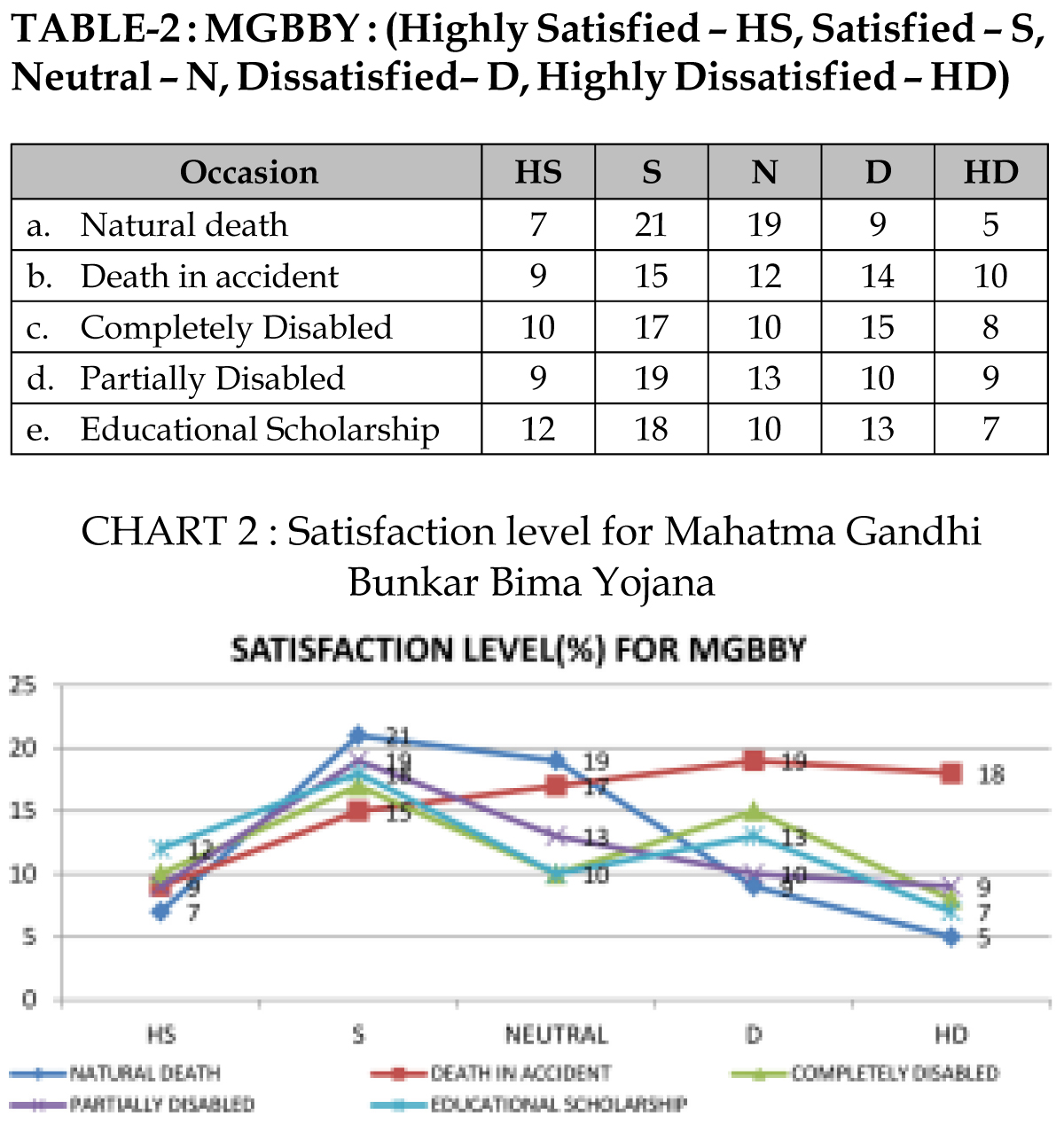 Analysis :
Analysis :
The opinion about the schemes was measured on 5 point Likert Scale in order to find out the satisfaction level. It was observed that satisfaction level was more for facilities such as Educational Scholarship, partial disability and natural death. Dissatisfaction was more for complete disability case. For natural satisfaction is 46.66%, for death in accident its 40%, for completely disable it is 45%, for partially disable it is 46% and educational scholarship it is 50%
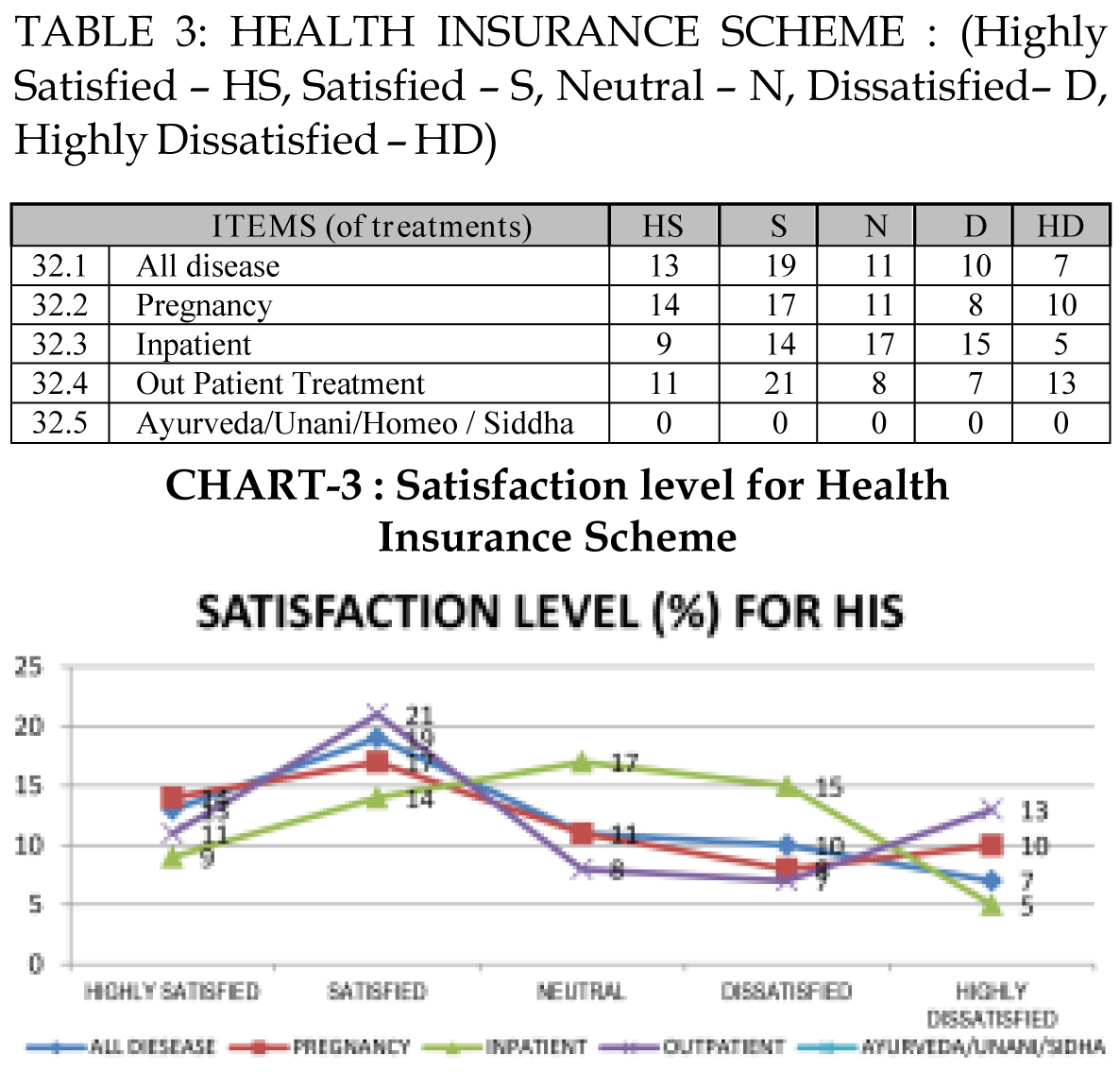 Analysis :
Analysis :
Of all the facility available the satisfaction rate is high for the outpatient treatment. None of them have used this facility for Aurveda/unani/homeopathy treatment. The awareness level for both health care schemes is found to be 100%.The satisfaction level for all disease coverage under this scheme is 53.33%,for pregnancy it is 51.6%, for inpatient it is 38.33% , outpatient it is 53.33%.
 Analysis :
Analysis :
The level of awareness for the RRR scheme is 76.66% and for CHDS scheme it is was found to be 73.33%.RRR scheme being introduced in 12th plan has gained popularity in short span of time.
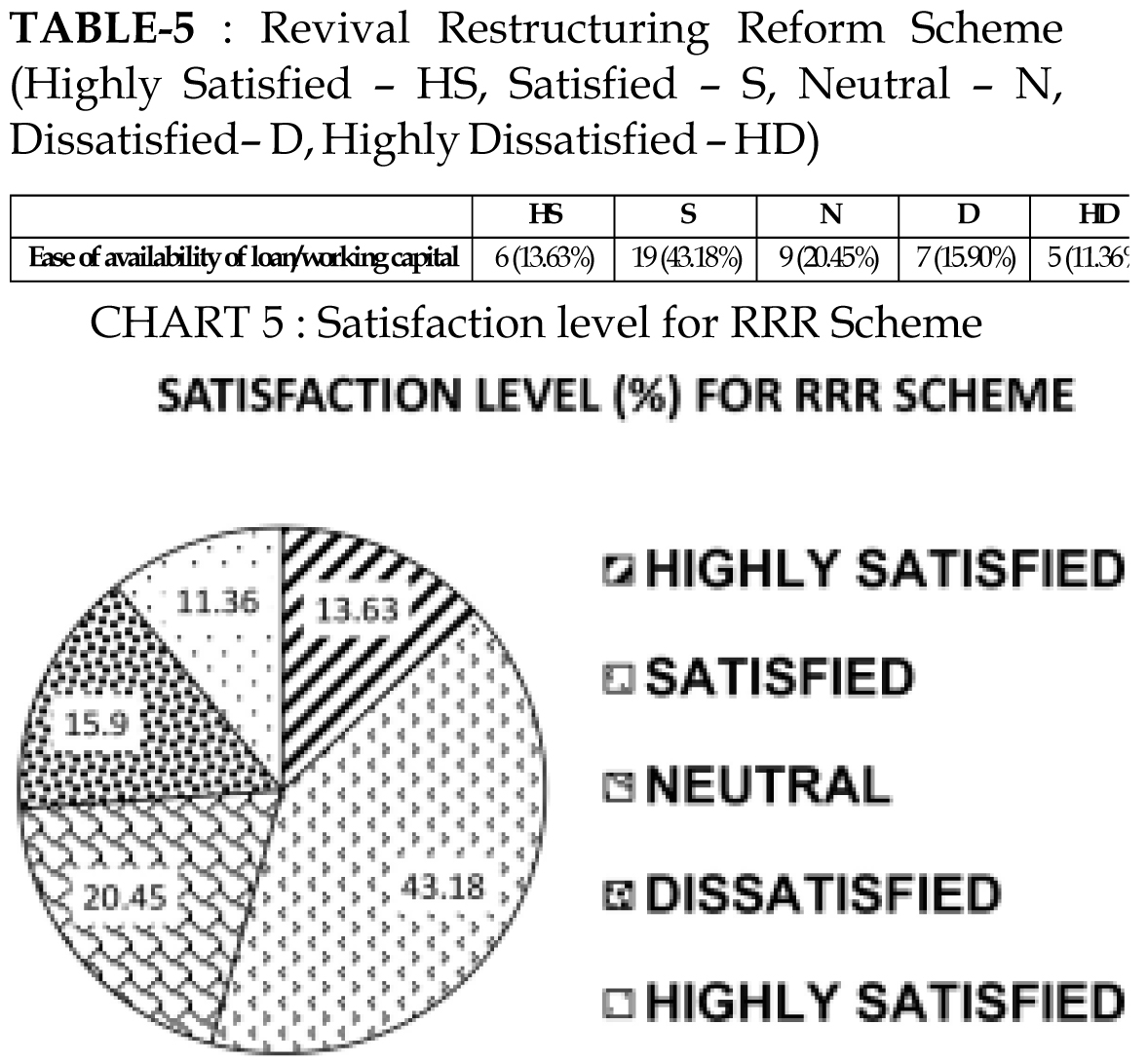 Analysis :
Analysis :
56.81% of the weavers who are availing this scheme are said to be satisfied or highly satisfied with this scheme. 20.45 % have neutral views about the same and 27.27% are either satisfied or highly dissatisfied. So the overall response is average for this intervention as half of the respondents are only satisfied.
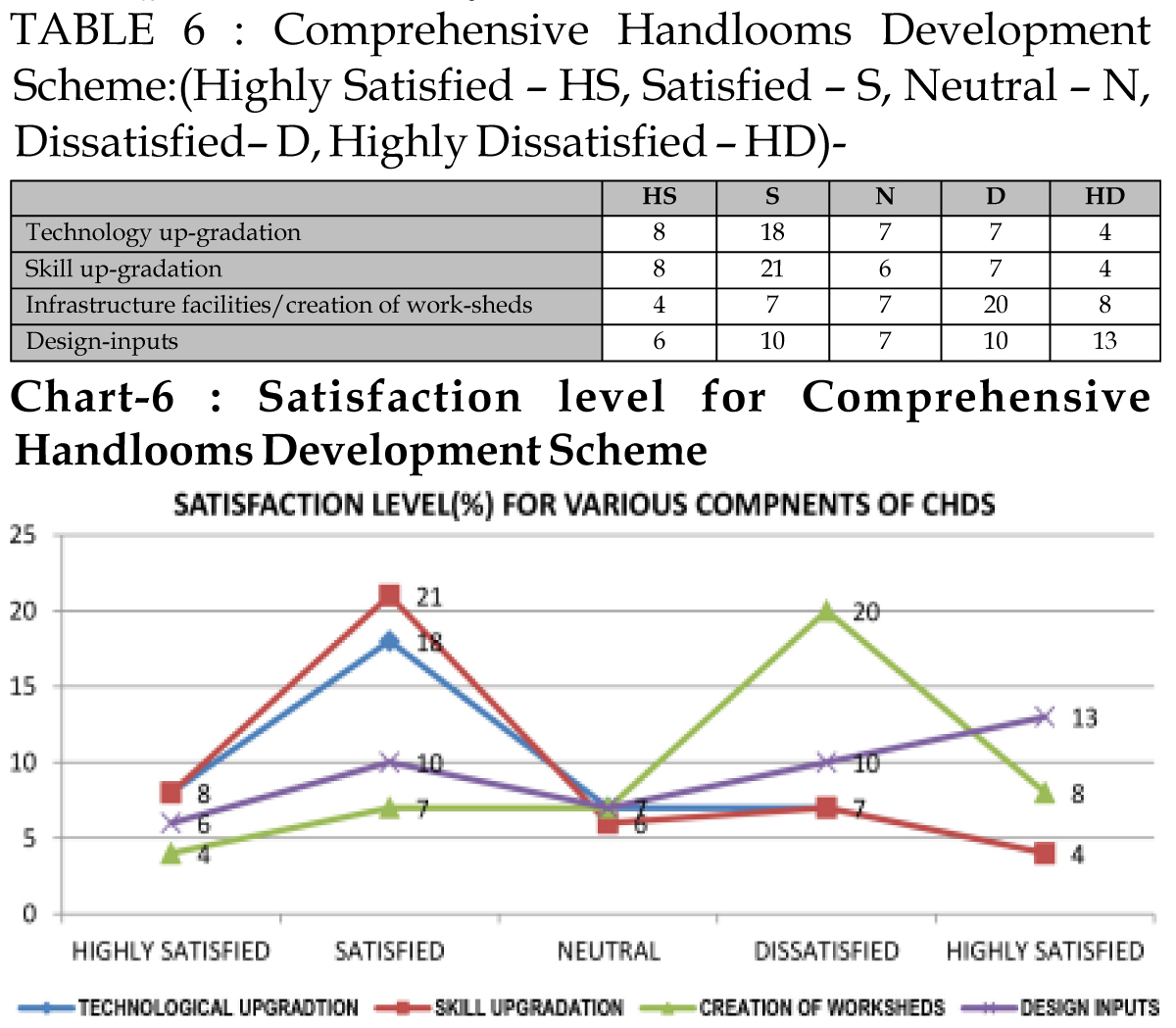 Analysis :
Analysis :
56.52 % weavers are satisfied with technological up gradation component of CHDS scheme.63.04% of weavers were satisfied with skill up gradation scheme. 60.86% of weavers were dissatisfied with infrastructure facilities component and 50% is satisfaction rate for design inputs component.
 Analysis :
Analysis :
The satisfaction level for Trade Facilitation Center & Yarn Supply was reported was reported to be 80%.
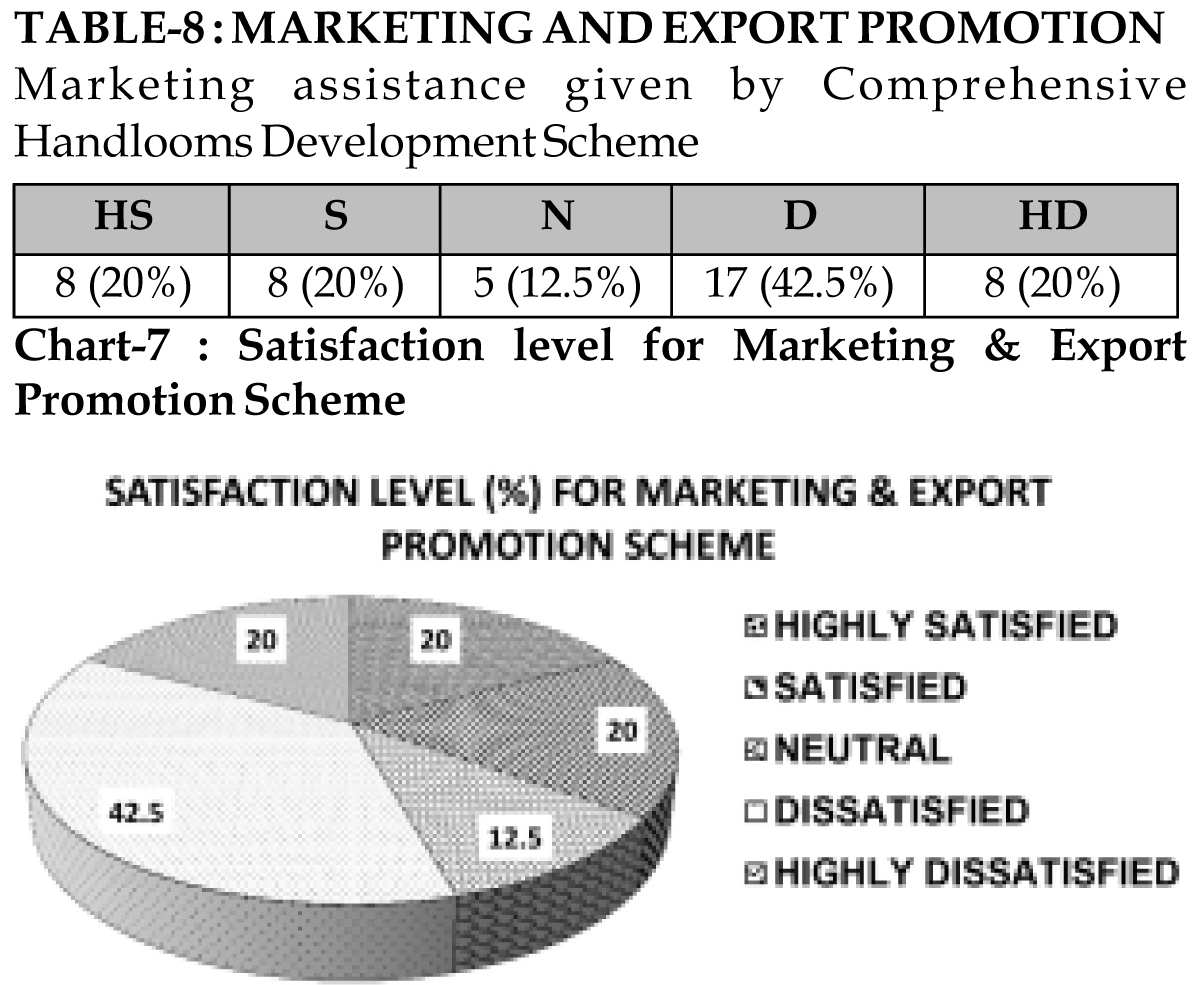 Analysis :
Analysis :
The satisfaction level was only 34.78% for this scheme where as dissatisfaction level was found to be 54.34%. The reasons stated for dissatisfaction was reported to be improper implementation of the scheme.
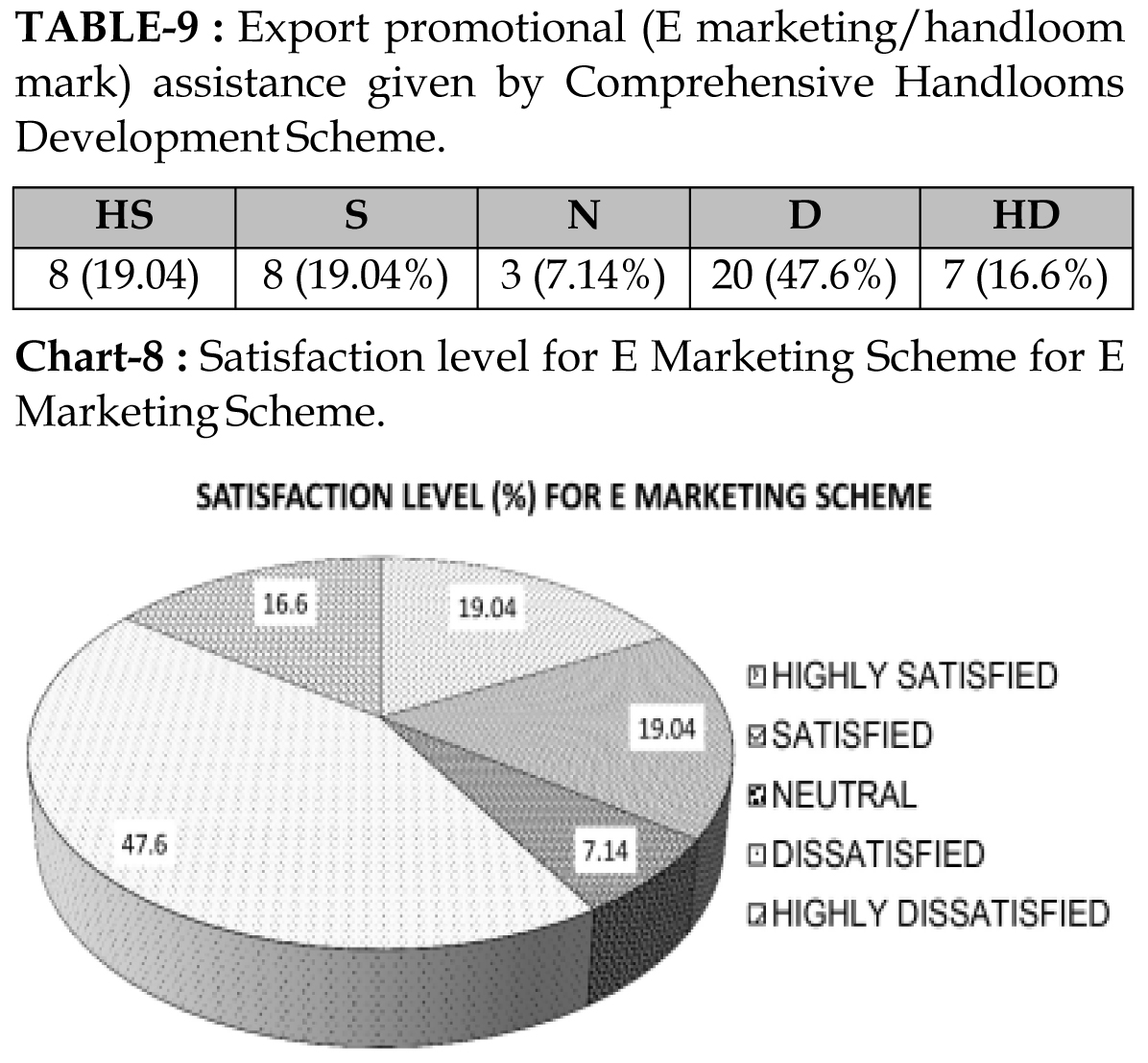 Analysis :
Analysis :
58.69% of the respondents are not satisfied with the scheme and reason was reported to be ease of availing the facility, the presence of intermediaries. Though they are aware of the scheme but are not able to utilize the benefits of it.
Conclusion
The study conducted on the handloom weavers revealed that the awareness level about the various government interventions was found to be 80.55%. Government has put multi faceted efforts for up-liftment of weaving workers which is visible in form of various schemes and interventions. Schemes for the healthcare have a better outreach among weavers. Dissatisfaction level was high(47.6%) for the Marketing & Export promotions component of CHDS. Role of intermediaries was the prime reason for this as the weavers were not able to avail the facility in spite of having the awareness about the scheme. The newly launched Trade Facilitation Center & Crafts museum and Yarn supply scheme have popularity level of 66.6% and satisfaction level is 80% for both. Trade facilitation center is giving a platform to showcase their skills directly to the consumers and maximize the profit share. Trade facilitation center & Crafts Museum Scheme though is having satisfaction level among the weavers , the outreach is less. The awareness is more among the master weavers and individual weavers who are well to do. The yarn supply scheme on the other hand is supporting the weavers by facilitating adequate supply of raw materials at cheaper rates. Almost 50% of the weavers are satisfied with the ease of availability of loan with RRR scheme. The women weavers are availing the benefits of HIS and MGBBY with the help of their health cards. The scholarship component of this scheme is major facilitator in making this scheme popular as they feel that education is the need of hour. The health care schemes are the most popular ones, followed by CHDS and RRR. Dissatisfaction was high for infrastructure development and design inputs facilities where as skill and technological up gradation facilities have been performing fairly well. The weavers were not very content with design inputs as government is not able to deploy trained designers at weavers service centers and so the latest designs which are in vogue are not accessible to them.
Suggestions
Government need to put in some more efforts specially in case of women weavers as they are mainly availing health care schemes only. As far as other schemes are concerned their spouses are solely involved in decision making about the schemes . Among the reasons stated for not being able to use the schemes the prime reason is presence of intermediaries. Due to the poor literacy rate among the weavers, they usually seek help from the intermediaries (Mahajans) who in turn take the benefits instead of the real beneficiary. Measures should be taken to remove them from the value chain. Some literacy programs should be launched so that the weavers who are working can get educated and directly interact with consumers and government officials. Measures should be taken to increase the outreach of Trade facilitation center and crafts museum. This intervention is majorly being availed by the master weavers or individual weavers who are well to do. The weavers who could actually be benefitted are not being able to do so. Therefore some awareness programs should be conducted in order to facilitate the outreach of the schemes.
References
